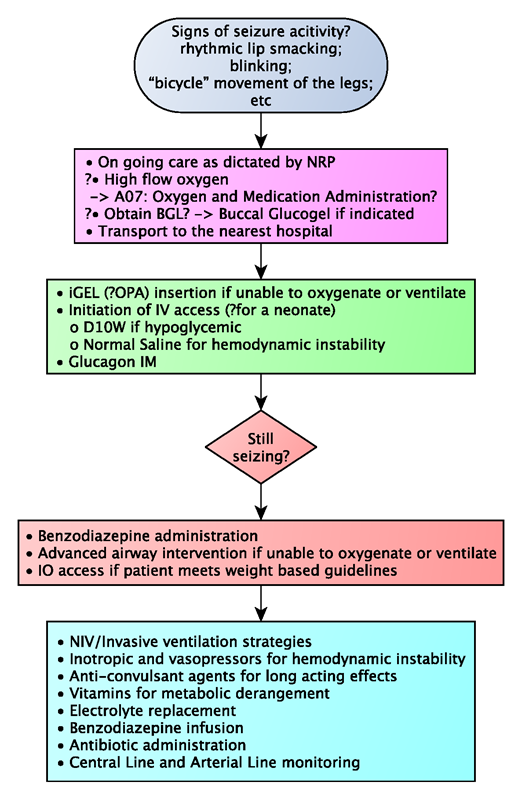Confirmation
Download PDF
Open All
M07: Neonatal Seizures
Updated:
Reviewed:
Introduction
- Identification of seizures in neonates and children can be difficult. Signs of seizures can include rhythmic lip smacking, blinking, or “bicycle” movement of the legs. Paramedics should treat ongoing seizures while considering reversible causes.
- The primary concern in neonatal seizures is hypoglycemia, which should be identified and corrected with a 2 mL/kg D10W bolus until the blood glucose is greater than 2.6 mmol/L. If IV access cannot be obtained, glucagon can be given intramuscularly (0.03 mg/kg).
- The preferred first line medication for control of a seizure lasting longer than 5 minutes, or multiple seizures without improving level of consciousness is a benzodiazepine. Midazolam can be administered via the intranasal (IN), intravenous (IV) or intramuscular (IM) route.
- IN 0.2 mg/kg
- IV 0.15 mg/kg
- IM 0.2 mg/kg
Additional Treatment Information
- If intractable seizure despite primary and secondary pharmacological treatment, critical care paramedics may consult with the transport advisor to consider:
- a loading dose of midazolam 50 mcg/kg followed by an infusion beginning at 120 mcg/kg/hr and titrating to effect
- a trial of Pyridoxine 50-100 mg over 1-2 minutes
General Information
- Patients requiring multiple sedatives or anti-convulsants have a high probability of requiring an advanced airway intervention and/or hemodynamic instability
Interventions
First Responder (FR) Interventions
- Prevent heat loss
Emergency Medical Responder (EMR) & All License Levels Interventions
- Provide on-going care as per neonatal resuscitation guidelines
- Transport urgently to closest facility
Primary Care Paramedic (PCP) Interventions
- Consider use of supraglottic airway if unable to oxygenate or ventilate with bag-valve mask
- Consider need for vascular access based on clinical scenario
- → D03: Vascular Access
- Requires specific training and Clinicall consultation (1-833-829-4099)
- Correct hypoglycemia:
Advanced Care Paramedic (ACP) Interventions
- Advanced airway intervention if unable to oxygenate or ventilate
- MIDAZOLam for seizure control
- Consider intraosseous access
Critical Care Paramedic (CCP) Interventions
- NIV/Invasive ventilation strategies
- Inotropic and vasopressors for hemodynamic instability
- Anti-convulsant agents for long acting effects
- Vitamins for metabolic derangement
- Electrolyte replacement
- Benzodiazepine infusion
- Antibiotic administration
- Central Line and Arterial Line monitoring
Algorithm
